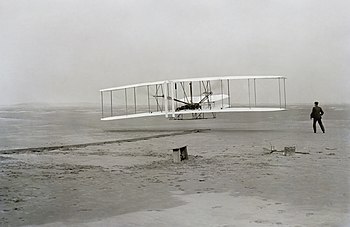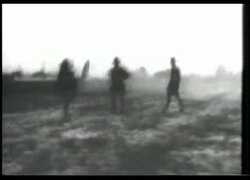Wright Flyer
| Wright Flyer | |
|---|---|

|
|
| Type: | Biplane - pusher propeller - airplane |
| Design country: | |
| Manufacturer: | |
| First flight: |
December 17, 1903 |
| Production time: |
1903 |
| Number of pieces: |
1 |
The Wright Flyer (aka Kitty Hawk Flyer , Wright Flyer I , or 1903 Flyer , the Wright brothers called themselves the aircraft The Whopper Flying Machine ) was the first of the Wright brothers made biplane - engine plane and flew for the first time on 17 December 1903 in Kitty Hawk , North Carolina . It was the first motorized aircraft that was heavier than air and controlled by a pilot . A self-constructed four-cylinder gasoline engine served as the drive. The power was transmitted by chain drives to two counter-rotating two-bladed propellers, which were attached as pusher propellers behind the wing.
The Wright Flyer was part of a development that began in 1899 with model kites, which in 1905 led to the first practical aircraft with the Wright Flyer III .
history
As children, Wilbur and Orville Wright experimented with a rubber-band powered toy helicopter. In 1896 the Wright brothers, who ran a repair shop for bicycles, were inspired by the work of the late mechanical engineer Otto Lilienthal and in 1899 began to make their own experiments with gliders . In their numerous glides to 1903 - the longest about 622.5 m at 26 s flight time - they found a workable design for a sufficient buoyancy supplied wing out, discovered the adverse yaw and developed a complete flight control about all three spatial axes. After these successes, the Wrights applied for a patent for their aircraft design on March 23, 1903 and decided to equip the apparatus with an aircraft engine.
construction
The Wright Flyer was a biplane with double rudders and double duck wings . The control around the longitudinal axis was carried out by twisting the wing ends. The flyer was driven by a motor that was installed close to the center of gravity and delivered its power to two counter-rotating pusher propellers . The propellers were self-made from three layers of spruce wood. The long and narrow blade shape found after a few attempts ensured that the propeller could achieve an efficiency of around 66 percent. I.e. two thirds of the engine power could be used for propulsion.
The engine was a completely self-designed four-cylinder in - line engine with a cast aluminum crankcase, which was also manufactured by the mechanic Charles Edward Taylor . It weighed only 81 kg (179 lb) and made twelve horsepower instead of the expected eight. Taylor later stated in an interview that the car engines available at the time weighed more than the entire Flyer including the newly developed power unit.
The supporting structure of the aircraft was practically an enlarged continuation of its glider from 1902. Like this, the flyer was made of oven-dried spruce wood ("West Virginia White Spruce") and the wings and tail units were covered with a muslin called "Pride of the West" . This solid cotton fabric contributed to the stability of the construction. Investigations of the flyer in the 1980s by Howard S. Wolko from the "US National Air and Space Museum" showed that the structure had significant strength reserves for the loads that actually occurred.
use
Despite poor weather conditions, the Wright brothers carried out their first flight attempt on December 14, 1903. Wilbur Wright oversteered the very sensitive flyer and the plane landed relatively hard after four seconds about 20 m after take off. It was slightly damaged in the process.
Flights from December 17, 1903
Then on December 17th, four flights took place, which are generally regarded as the historical first flights. The last flight that day lasted 59 seconds, covering a distance of 260 m.
At 10:35 a.m., Orville Wright took off for the first time that day. In contrast to the first attempt at flight on December 14th, the launch track was not slightly downhill, but laid horizontally throughout. Orville flew for 12 seconds. He reached a speed of 16 kilometers per hour and a distance of 37 meters or 120 feet. For the other flights, the Wright brothers took turns, breaking one record after the other: After Orville flew 37 m in 12 seconds, Wilbur flew 53 m (175 feet) in 13 seconds. On the third flight, Orville flew 200 feet (61 m) in 15 seconds.
A total of four flights were completed on December 17, 1903 - two each from Orville and two from Wilbur. On the last flight, Wilbur allegedly covered 259.7 meters (852 feet) in 59 seconds, which was the daily high. It was not until 1908 that the Wrights published a photo of the flight of 1903, which is now controversial, because the photo could show a later, two-seat aircraft model of the Wrights from the year of publication 1908 due to special features. According to experts, the three "dots" on the plane are the engine (left) and the two occupants, as can be seen on film footage of the two-seater from 1908, and the distance does not correspond to the alleged 852 feet.
The Smithsonian Museum also made a contract with the Wright heirs never to claim that there was a motorized flight before the Wright brothers.
resonance
After a single press release in January 1904 and a failed public flight demonstration with the Wright Flyer II in May 1904, the Wright brothers initially did not publicize their efforts. It was not until 1908 that Orville in the USA and Wilbur in France presented their flyer, which had been further developed into the Wright Model A, to a broad public.
Whereabouts
After the fourth and last flight, the Flyer was so badly damaged by a gust of wind and subsequent rollover that it was no longer rebuilt. The wreck was stored in Dayton . During a flood in 1913 it was almost completely destroyed. It was shown at numerous exhibitions over the next two decades, but moved to the Science Museum in London in 1928 as a result of a dispute between Orville Wright and the Smithsonian Institution . After the dispute was settled and Orville Wright died, the machine returned to the United States in 1948 and was shown in the Smithsonian's Arts and Industries Building in Washington, DC. Since the opening of the National Air and Space Museum on July 1, 1971, the flyer has been the central exhibit in the collection.
Technical specifications
| Parameter | Data |
|---|---|
| crew | 1 |
| length | 6.43 m |
| span | 12.30 m |
| height | about 2.70 m |
| Tread depth | 1.98 m |
| Wing area | 47.38 m² |
| Area of the (canard) elevator | 4.46 m² |
| Surface of the rudder | 1.95 m² |
| Wing extension | 6.38 |
| Empty mass | about 275 kg |
| Max. Takeoff mass | 338 kg (with pilot) |
| Top speed | about 48 km / h |
| Engines | a water-cooled in-line four-cylinder (lying) with 3300 cm³ displacement and an output of 8.25 to 16 hp (12 hp on the first flight) |
| Diameter of the propellers | 2.59 m |
gallery
swell
- James Tobin: Conquering the Sky - The Wright Brothers and the Beginnings of Aviation . Droemer, Munich 2003, ISBN 3-426-27314-4 .
Web links
Remarks
- ↑ It is possible that Gustav Weißkopf made the first powered flight on August 14, 1901. However, he was unable to document this sufficiently.
- ↑ It is possible that Karl Jatho made his first powered flight on August 18, 1903 with the Jatho kite . However, he was unable to document this sufficiently.
Individual evidence
- ↑ a b c d e Richard Hallion: The dream takes flight (The Wright Flyers Database) , in Airplane Monthly December 2003
- ↑ a b c d e f http://www.doppeladler.com/misc/wright.htm (June 23, 2012)
- ↑ a b http://airandspace.si.edu/exhibitions/gal100/wright1903.html
- ^ Joe W. McDaniel: Just the facts - 1902 Wright Glider. In: Wright Brothers Airplane Company. 2010, accessed August 30, 2020 .
- ↑ Murson Kenneth: aircraft , hawk-Verlag, Erich Sicker, Wiesbaden 1972, ISBN 3-8068-8003-4 , page 4-5.
- ↑ To cover the flyer ( Memento from July 31, 2012 in the Internet Archive )
- ↑ a b http://www.thewrightbrothers.org/fivefirstflights.html (June 23, 2012)
- ↑ Archive link ( Memento from May 7, 2012 in the Internet Archive )
- ↑ a b c Pioneers in the Sky - The Riddle of the First Flight , on: zdf.de, accessed July 24, 2016
- ↑ James Tobin, The Conquest of Heaven , pp. 314-318
- ↑ Richard P. Hallion: Wright Flyer survivors in Airplane Monthly, December 2003, p 74






